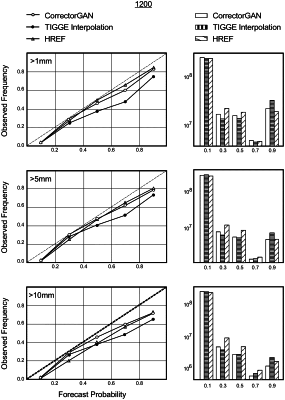| CPC G06N 3/08 (2013.01) [G01W 1/10 (2013.01); G06N 3/045 (2023.01)] | 20 Claims |

|
1. A method for training a generative adversarial network (GAN) for correcting and downscaling global numerical weather forecast data to generate an ensemble of forecast data for a target meteorological variable at a target spatial resolution, comprising:
pre-processing the global numerical weather forecast data to generate an ensemble of corrector input data at a first spatial resolution,
wherein the first spatial resolution is lower than the target spatial resolution,
wherein the GAN comprises a generator deep neural network (G-DNN) and a discriminator deep neural network (D-DNN),
wherein the G-DNN comprises a corrector deep neural network (C-DNN) followed by a super-resolver deep neural network (SR-DNN) having an output spatial resolution at the target spatial resolution, and
wherein the generated ensemble of corrector input data comprises data for the target meteorological variable and at least one context meteorological variable different from the target meteorological variable;
down-sampling observational data for the target meteorological variable from a second spatial resolution to the first spatial resolution, wherein the second spatial resolution is higher than the first spatial resolution, and wherein the observational data for the target meteorological variable corresponds to the ensemble of corrector input data over geopatch-time indices;
pre-training the C-DNN, using a first C-DNN loss function independent of the SR-DNN and D-DNN, wherein the first C-DNN loss function is computed based on a first C-DNN output generated from the ensemble of corrector input data, and the down-sampled observational data;
pre-training the SR-DNN, using a second SR-DNN loss function separate from the first C-DNN loss function and independent of the D-DNN, wherein the second SR-DNN loss function is computed based on the first C-DNN output, the down-sampled observational data, a first SR-DNN output generated from the first C-DNN output, and the observational data for the target meteorological variable; and
training the GAN, using a third D-DNN loss function computed based on a second C-DNN output generated from the ensemble of corrector input data and a random vector input.
|